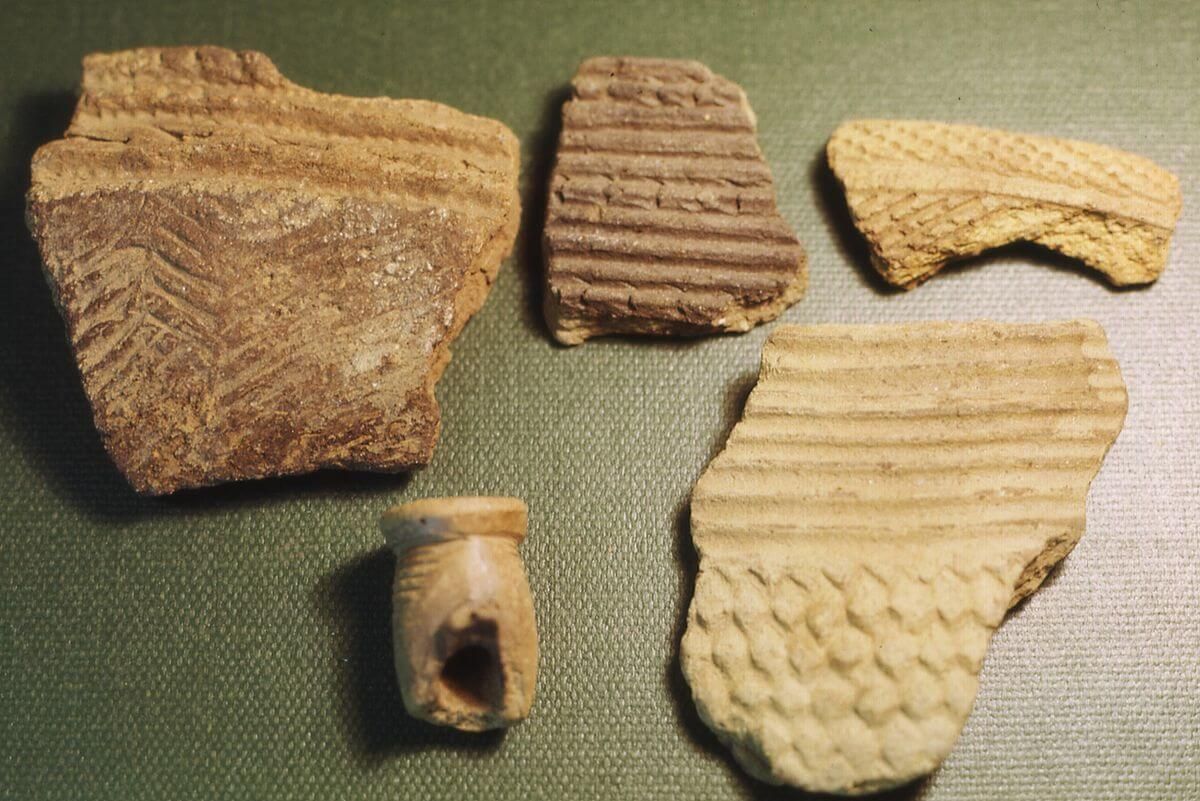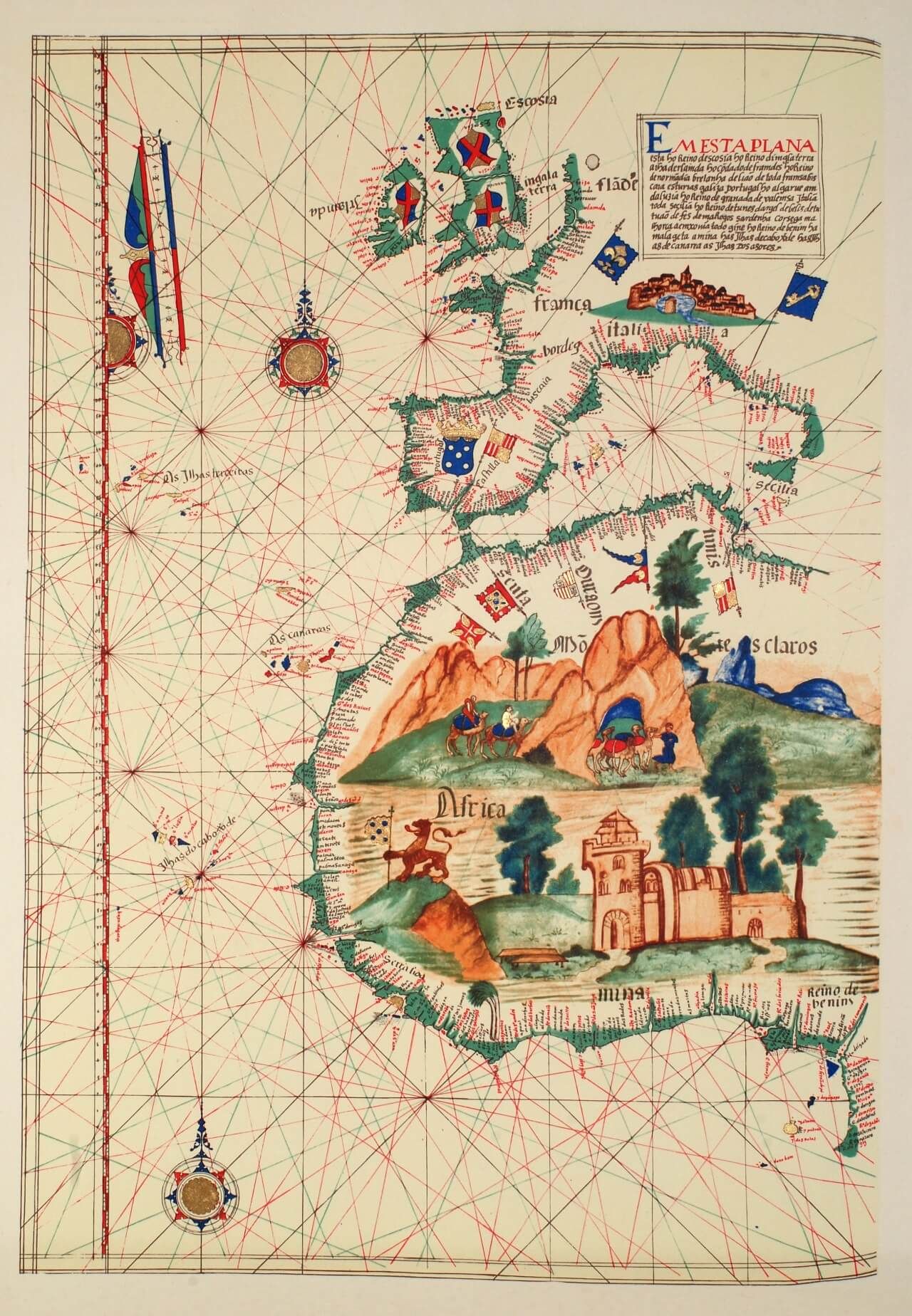Sierra Leone and its place in West African History
When the name "Sierra Leone" is mentioned, most people think of the country which emerged as a British Colony after Freetown was created in 1807 as a home for freed slaves returning to Africa from London and Nova Scotia.
In fact, archaeological investigations show that this part of the Upper Guinea Rain Forest has been inhabited for more than 2,500 years and almost certainly for millennia before that.

Stone Age Pottery fragments from Bombali District: Makeni University — © John Atherton
Pottery
Jump to section titled: PotteryWhen the Portuguese first explored West Africa in the 15th Century they found cities and civilisations in the area of modern Ghana which rivalled their own. Further west, in what is now Liberia, Sierra Leone and Guinea, the dense rain forest made movement and settlement more difficult and most people lived close to the coast, on islands or along river valleys.
Early settlers to Sierra Leone (2000 - 3000 BC) are believed to have travelled south from the Saharan region as the climate became drier and the area of desert expanded. They also came from the region of ancient Mali.
When the Portuguese discovered the Western Peninsula and named the Lion Mountain in 1460, the local population was dominated by the Kingdom of the Bulloms on the north side of the Sierra Leone River Estuary and the Mane to the south. The Temne army arrived from the north in 1505 and occupied the southern shore of the Estuary.

Extract from the Map of Western Africa; Lázaro Luis (1563). Elmina Castle in Ghana lies to the right of the Lion standing proudly on Sierra Leon, as two of the most prominent features on the Map: From the Metropolitan Museum of Art; New York.
Pottery Extract from the Map of Western Africa; Lázaro Luis (1563). Elmina Castle in Ghana lies to the right of the Lion standing proudly on Sierra Leon, as two of the most prominent features on the Map: From the Metropolitan Museum of Art; New York.
The Portuguese arrived as traders and missionaries and spent most of the 16th Century establishing small trading centres along the lower sections of rivers leading into the interior. Port Loko was one of their main settlements. This gave them control of the inland trading routes. One of the earliest references to trade from Sierra Leone (Jarric, 1614)1 is the export of Kola nuts to the Barbary Coast (modern Tunisia).
The Portugese and Spanish carried out early colonisation of the Canary Islands and Cape Verde Islands off the coast of West Africa in the 14th and 15th Centuries and gradually trading continued further south and east along the coast throughout what was called Senegambia (the Countries from Senegal to Ghana) and the more eastern countries of modern Benin and Nigeria.
During the sixteenth century other European Nations became active in the exploration of West Africa. The Dutch, British and French all rivalled each other in seeking new trading opportunities for Gold, Elephants’ teeth (tusks, Ivory), and Camwood (a dye). The capture and transport of slaves was a characteristic of local tribal wars and only became part of international trade in the early 17th century. Countries in Europe were at war with each other for decades. The hostilities extended into Africa with changing alliances. Rival admirals, individual privateers, and companies like the Royal African Company of England and the Dutch East India Company engaged in skirmishes and local wars in order to maintain their countries’ dominance in different regions.
The Story of Tasso Island
Jump to section titled: The Story of Tasso IslandThe British began to visit the Sierra Leone River Estuary from 1500 onwards on a regular basis, including voyages by John Hawkins and Thomas Hampton in October 1562 and Sir Francis Drake in 1566.
From a search of the literature, the first direct reference to Tasso Island appears in 1635 as the 'ilha de taco (Carvalho). Early relationships between the British and local rulers appear to have been fractious and a trader noted in 1659 that the English had returned to Tasso, while a Dutch account, written in 1662, refers to the ‘English on Tasso’ and the fact that they had had a quarrel with the King of Carecole and abandoned the Island.
The Royal African Company of England was established in 1660 by the Duke of York (Later King James ll) and the first record of permanent settlement appears in the companies records when its London Agents instructed its ships captains to establish ‘factories’ on Sherbro (York) and Tasso Islands. These ‘factories’ were semi-fortified compounds designed to hold trading goods until the ‘trade winds’ were blowing in a favourable direction for sailing ships to travel to and from England.
Early settlement of Sherbro, York, Banana, Tasso and Bunce Islands was undertaken in negotiation with the resident kings and their chiefs (in the case of Tasso, the Bulloms from the Lungi peninsula) and throughout the next two centuries these agreements were critical, guaranteeing use of the land and the payment of rent to the local chief. Early references are made to the Chief of Kumba Bai village on the Rokel River and it is interesting to note that the strongest supporter of the Tasso Ecotourism Project today is Chief Pa KumbaBai of Oko Town.
Due to the risk of hostilities from rival trading nations, each European country set out to build permanent forts which could be garrisoned against invasion. In 1664, the British challenged the supremacy of the Dutch by attacking forts in Ghana and mistreating Dutch traders elsewhere along the Guinea coast. The Dutch, under Admiral De Ruyter, retaliated and destroyed Britain’s first fort on Tasso Island (see "Dapper’s Account of the Dutch Raid on Tasso Island, 1664" below) which was subsequently replaced by a new fort on the neighbouring ‘Bens’ Island, variously called Bence and Bunce Island over the years.
Dapper’s Account of the Dutch Raid on Tasso Island, 1664 On the island in the River of Serre-Lions, the English possessed a small Fort, erected for the more secure managing of their Trade, which in the Year Sixteen hundred sixty and four, the tenth of December, the Dutch under the Conduct of the Admiral De Rutter, with a Fleet, without reason, surprizd and took; wherein they found four or five hundred Elephants-Teeth, a good number of Copper-Kettles, Iron Bars and about sixty or seventy lasts of Salt; the later parcels, with some other inconsiderable Merchnadises, they left there; but the Teeth and other Wares of consequence they brought over to the returning ships.
Although Bunce Island was to become the long term British stronghold, Tasso Island remained as its principal plantation and factory due to its greater size and opportunities for producing agricultural and other produce. A visitor to Bunce Island noted in 1722 that they had passed the remains of the Tasso Lodge, abandoned because of high mortality (no doubt because of the swampy nature of the Island) , but the author also implied that final abandonment only took place in recent years (Houston, 1725).
In the 1680’s and 1690’s Tasso Island, along with James Island at the mouth of the Gambia River and York Island close to Sherbro, formed the three slaving stations for the Royal African Company.
Slaves were shipped to Jamaica, Barbados and the Leeward Islands from these locations but at the same time ships were returning directly to London and other English Ports carrying camwood, bees-wax, hides and ivory.
The Royal African Company was continually pressing its local agents to develop new trading activities, one of which was the manufacture of indigo dye from two species of plants; one imported from India and the other growing naturally in the lowland forests of Sierra Leone.
Tasso became the main centre for experiments in the production of Indigo which was a complex process and involved dirty and debilitating work – both in planting and tending the indigo seeds and vines and in harvesting the leaves which were steeping in water and chemicals and then pounded to release the dye component. "Tending the fermenting leaves, which let off disgusting fumes and attracted swarms of flies, was easily the most unpleasant of the indigo processing tasks" (Kriger, 2010). Numerous attempts were made to grow and process indigo from 1684 to 1699, with two successful harvests being recorded on Tasso in 1695 and 1697. The 1697 harvest produced 246 lbs of indigo cake which was shipped to London the following year.
Work on indigo production was carried out by local ‘free’ Africans and mixed race ‘gromettos’, many of whom were reluctant to be involved. In 1692, four carpenters, who had been hired to build the vats on Tasso, deserted the company and in December 1693, fifteen men and three women ran away, taking with them "four muskets, four fowling shotguns, and two pairs of pistols" (Kriger).
The challenges in growing indigo were not confined to the difficulties of employing workers; seedlings rotted in the rains or were eaten by caterpillars, the local population was afraid of frequent raiding parties from French ships, and buildings and stores were at risk of being burnt to the ground by rival traders and privateers.
The development of synthetic dyes eventually destroyed the natural indigo market. By 1702, the Royal African Company was exhorting its agents to try growing cotton instead, together with supplies of ginger, sugar-cane, peper, spice, gum, trees and drugs insisting that "in the garden on Bens Island or at Tasso Island they set, sow and plant all things that might be improvable for trade". (Kriger).
Little has been found in the historical record of activities on Tasso during the 18th Century, but it is clear that the island continued to be used as a support to the main slaving and trading activities on the neighbouring Bunce island, including supplying most of that island’s needs for fresh water from the springs at Oku Town which are still used today.
Note on Historical Research
Jump to section titled: Note on Historical ResearchAs part of the Tasso Ecotourism Project, serious study is being undertaken, through use of national and international archives, to trace the history of Tasso Island, together with local exploration on the island.
Principal Sources include:
- Paul Hair, Adam Jones, Robin Law (1992) Barbot on Guinea: The Writings of Jean Barbot on West Africa, 1678-1712, Vol 1 & 2. Hakluyt Society.
- Dapper, Ofert, Translated by John Ogilby, 1668
- The Records of the Royal African Company held in The National Archives, Kew, London.
- James Curry (2013) Commercial Agriculture, the Slave Trade and Slavery in Atlantic Africa, edited by Robin Law, Suzanne Schwarz, Silke Strickrodt.
- Simon Schama (2007) Rough Crossings; The Slaves, the British and the American Revolution. Harper Collins.
© Peter Nelson; Bristol, February 2018
1 Pierre du Jarric, Histoire des choses plus memorables advenues tant ez Indes Orientales, que autres païs de la decouverte des Portugais, en l’establissement & progrez de la foy Chrestienne & Catholique; Et principalement de ce que les Religieux de la Compagnie de Iesus y ont faict, & enduré par le mesme fin. Depuis qu’ils y sont entrez jusqu’a l’an 1600, 3 vols. (Bordeaux: Millanges 1610 - 1614) Universität Wien